First Atlantic Ocean crossing by a wireless signal |
| Mahlom Loomis | Marconi and the Bristol Channel | Marconi and the transatlantic wireless | Epilogue et sources |
June 1900: Marconi decides on transatlantic test, to proceed without delay. In July Marconi visited south-west Cornwall (England) to inspect suitable sites. The chosen location was on a headland above a cove at Poldhu. The place is well located to make it possible the waves to join the East coast of the United States without meeting ground or mountains Work began in October to construct the first of the transatlantic stations. A transmitter was powered by a 32-brake-horsepower oil engine, driving a 25kw alternator and connected to 20, four-piece, 200 ft masts in a circle of 200ft diameter. (on the right) On 17 September 1901, on the verge of completion, Poldhu's giant aerial collapsed in a gale. A temporary aerial was constructed using two of the original masts. This was the aerial configuration in place during the transatlantic experiments in December 1901. Marconi’s mind turned to methods that he had employed a number of times before. Kites and hydrogen balloons had been successfully used to provide height for aerials in earlier transmission situations. On Monday, (across the Channel). |
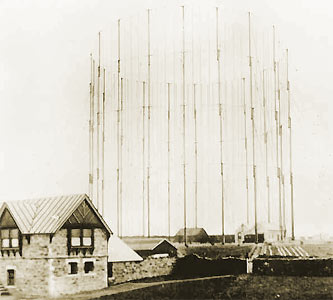 |
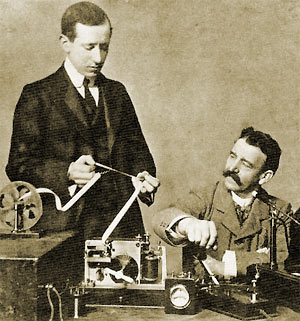 |
Dec. 9, Marconi's boxes of material were relocated from the ship to the facility atop Signal Hill (Newfoundland ). The equipment was composed of an aerial wire, six kites, two hydrogen balloon skins and twenty-five cylinders of hydrogen gas. By cable, Marconi asked Poldhu, with its temporary aerial, to transmit the Morse letter 'S' for three hours every day. On Tuesday testing began. One kite was raised with 600 feet of aerial wire to ensure that the system would function. On Wednesday, in foggy conditions, a balloon, 14 feet in diameter and holding 1000 cubic feet of hydrogen, was tested. The wind suddenly increased. The balloon tore away and was lost into the Atlantic Ocean. Carefully considering the strong winds atop Signal Hill, it was determined that the kites would be most likely to withstand the elements. On Thursday 12 December the wind was even stronger. A kite was lost because a gusty gale |
|
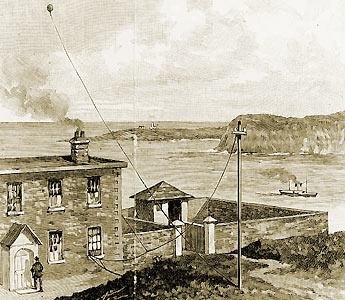 |
||
Marconi (left) with his assistant Kemp, 1901. They are pictured with some of the equipment assembled for the transatlantic test at Signal Hill. |
Premises at Signal Hill, used by Marconi to house a wireless receiving station |
|
The following account is by Hal Holwell (julyn 2001). His father William Holwell, was one of the crew Marconi used to fly the kite that lifted the wireless aerial on Signal Hill, this 12 December, 1901 |
William Holwell held the line attached to the large kite sail. On the leeward side of the kite sail was Marconi's assistant, William Paget. The wind was constant and cold. Holwell marvelled at the men, Marconi, George Kemp and Paget, and their determination to defy distance with strange equipment. He and the others pulled as Paget let go of the kite. The heavy cord went taut, the kite rose and pitched wildly from side to side. Tumultuous winds, a constant feature of Signal Hill, made it difficult to steady the kite and maintain the required altitude for the aerial. An aerial wire was attached to the kite at one end and to a ground plate in the earth at the other. Flying the kite with this extra anchor point and in these strong winds was an arduous task. Finally, the kite flyers hung on in the bone chilling wind. |
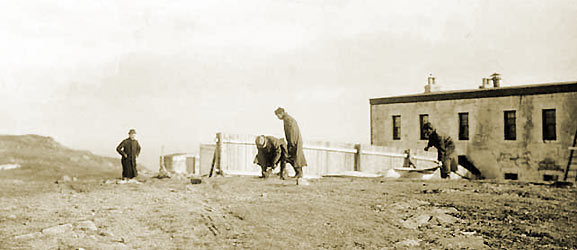 |
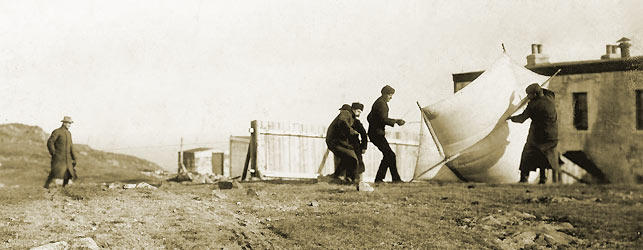 |
Inside the building, a wireless receiving device, known as a coherer(*), was attached to a wire running through the window frame and to the wavering and unsteady aerial suspended by the kite. The kite continued to buck in the strong wind. It pulled roughly against Holwell’s grip. Since the aerial fluctuated wildly, Marconi could not use the intended receiving device to give full proof of any signal reception. A Morse recorder, which was capable of receiving signals and inking them on a strip of paper, would not work with the unstable antenna. Marconi improvised and used a telephone receiver, listening intently. |
Marconi and his assistants launching the kite-supported aerial at Signal Hill. Marconi is seen on the left. |
He held it close to his ear and listened for the signal that he believed could span the Atlantic. The tension was palpable, but the wireless pioneers remained calm and intent, fervently hoping for a sound. |
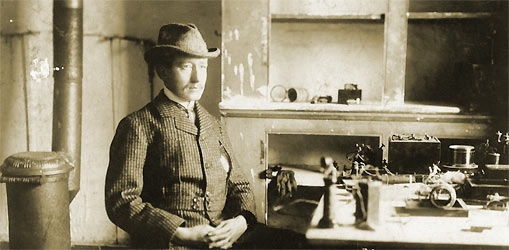 |
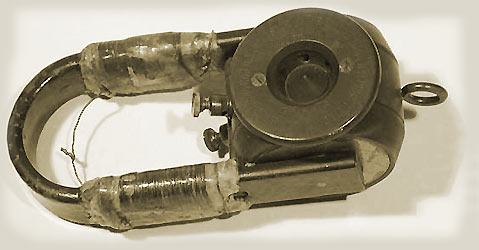 |
Marconi is seated inside the receiving room at Signal Hill. |
Telephone receiver used to receive the first transatlantic message in 1901 |
Then, out of the ether, faint but distinguishable - came the sound of three dots - the International Morse Code signal for the letter “S”. It was 11:30 a.m. Marconi quietly passed the receiver to George Kemp. He listened. Once more the signal came and Kemp nodded. |
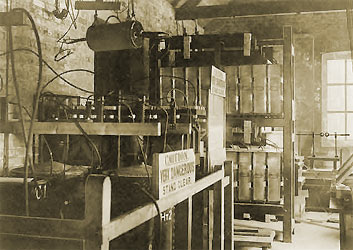 |
Only two people had heard the signals through the receiver. None had been recorded on the Morse inker device. The signal was transmitted from Poldhu near Mullion, a distance of some 3,000 kilometres (1865 miles) It was the first time that the Atlantic Ocean had been bridged by a wireless signal! William Holwell and the others flying the kite were invited nside to warm themselves and |
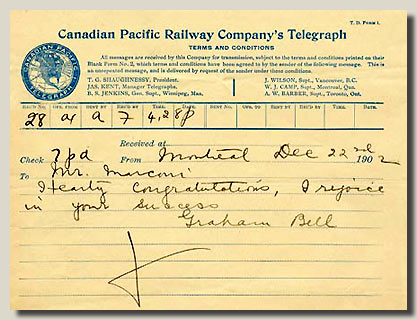 |
The transmitting room at the Poldhu wireless station |
||
have some hot cocoa. The kites were quietly packed in shipping crates and sent back to the Marconi Company in Chelmsford, England.
Their role completed, they went into storage. |
||
| A telegram of congratulations by Alexander Graham Bell to Marconi: 'Hearty Congratulations, I rejoice in your success - Graham Bell' |
||
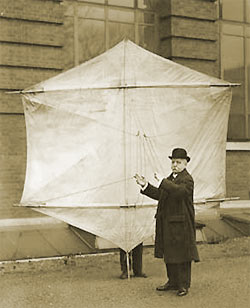 |
This signal proved beyond all doubt that his wireless system could travel around the curvature of the earth and over tremendous distances. |
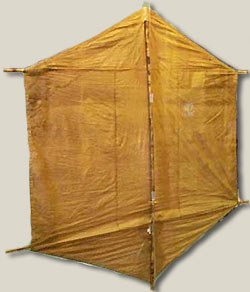 |
The Kites There were six kites and may have been of varying sizes since there is mention of one kite being 9 feet tall. Others measure out at about 6’2” in height. All of the kites were of the Baden-Powell type. The kites were manufactured by G.C. Spencer and Bros. Ltd., Highbury, London, England. Spencer was a well known supplier of balloons and kites. At least two of the kites broke away during the four days of flight. One was recovered from the Captain of a fishing boat and the other from a valley on the north side of Signal Hill. Only two kites are known to remain from the set. One consists of only the sail; the other is complete with sail, frame and part of the bridle intact. The sail of the complete kite measures 6’ 2.4” high by 5’ 9.5” wide. The sails are of heavy cotton cloth. All outside edges were reinforced with linen tape and sewn with cotton thread. |
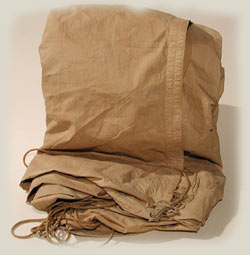 |
| Five separate cloth panels were sewn together to make each kite sail. At key stress point locations, where the frame and bridle attached to the kite sail, additional cotton cloth reinforcing panels were sewn in place. Brass grommets were used to provide access points to attach the frame and bridle to the kite sail. The frame consists of three bamboo poles. The longeron is 6’ 6’’ in length and the cross spars are 7’ in length. Thus, when fully assembled, the spars extend beyond the height and width of the sail. The bridle was made of strong hemp cordage and was attached to the kite in six places. There is no evidence of a bowing system for the kite in any photos or archival documents extant. |